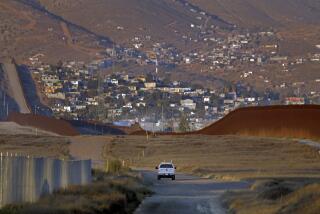Killing of Border Patrol Agent Brian Terry detailed in court papers
- Share via
WASHINGTON — “I’m hit! I’m hit!” U.S. Border Patrol Agent Brian Terry cried into the southern Arizona darkness that night, Dec. 14, 2010. “I can’t feel my legs!”
The 40-year-old Border Patrol agent, who was less than four years on the job, collapsed and died in the desert brush near Rio Rico.
Terry’s killing unraveled the Justice Department-sanctioned “Fast and Furious” gun-tracking operation and triggered one of the biggest political controversies of President Obama’s first term. The scandal drove out the head of the federal Bureau of Alcohol, Tobacco, Firearms and Explosives and left Atty. Gen. Eric H. Holder Jr. in contempt of Congress for refusing to turn over records.
As a Mexican bandit faces a sentencing hearing next week in the slaying, newly released federal court affidavits reveal for the first time eyewitness accounts describing the gun battle between a gang of thieves and four U.S. agents, including Terry.
Terry and his fellow agents were part of an elite Border Patrol tactical team that had been working the area for several nights, 11 miles north of the U.S.-Mexico border. The Fast and Furious operation was intended to encourage gun dealers to sell thousands of illegal firearms to bandits so ATF agents could track the buyers back to Mexican drug cartels.
An hour before midnight, Terry and the other agents were alerted by radio that sensors had picked up foot traffic in the rugged canyon below. They used night-vision equipment to locate several men.
“I saw a group of approximately five men in the wash heading west, towards us,” said Agent William Castano, according to the affidavit. “At least two of the front men were armed with rifles. They were carrying their guns at the ‘low ready’ position, a position that made it easy for them to fire.”
Agent Gabriel J. Fragoza saw their “long rifles and backpacks.” They were, he said, “looking for something, and ready to shoot.” Agent Timothy Keller said he saw one of the bandits with a hand on the grip of his rifle, the other on the barrel.
Castano yelled out in Spanish: “Policia! Policia! Drop your weapons.”
The bandits turned and faced them, and the agents fired several nonlethal warning rounds with a bean-bag gun. Fragoza hollered for them all to duck down. Castano said he lost his footing on the hill “and fell after shooting at least one bean-bag round.”
The bandits returned live fire. The agents fired back. Castano heard Terry shout and ran to him. “I’m paralyzed,” Terry said. According to Castano, “Agent Terry soon lost consciousness and died at the scene.”
Fragoza heard Terry scream twice he had been hit. He also heard “moaning” from the bandits. Keller said he “saw two distinct muzzle flashes coming from the wash” and heard shotgun fire as well. “I was in fear of my life,” he said.
The bandits scattered south for Mexico. But Manuel Osorio-Arellanes, a Mexican national, was shot in the torso and unable to run. Agents found a live round in the chamber of his assault rifle and 24 more in the magazine. A second magazine was loaded with another 25 rounds.
Two of the assault weapons recovered that night were later traced to the Fast and Furious operation.
Though the search for some of the desert bandits continues, Osorio-Arellanes, who pleaded guilty to first-degree murder in October 2012, is to be sentenced Monday in federal court in Tucson, where he could receive from 30 years to life in prison. Terry’s mother and siblings plan to address the court about their loss.
Another suspect detained in Mexico is awaiting extradition to this country, and three more remain in hiding, court records show.
A rock-and-mortar memorial stands where the agents confronted the bandits. Robert Heyer, a Terry family spokesman, said Wednesday that they hoped to visit the area Sunday, before the sentencing hearing.
“We’re going out there to see where Brian died,” he said.
More to Read
Sign up for Essential California
The most important California stories and recommendations in your inbox every morning.
You may occasionally receive promotional content from the Los Angeles Times.











